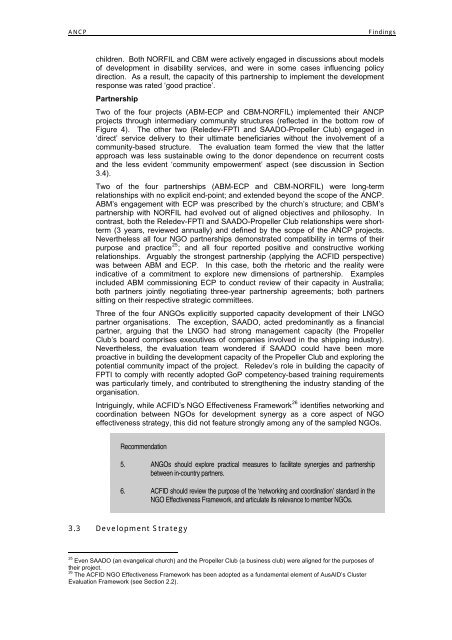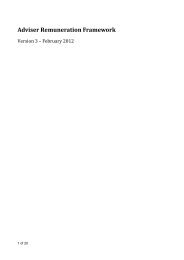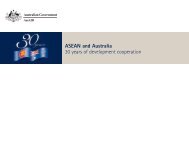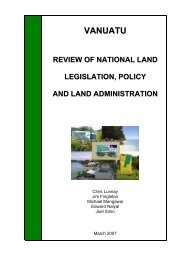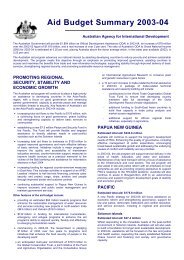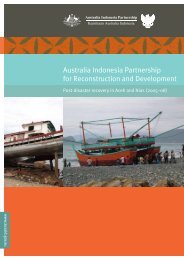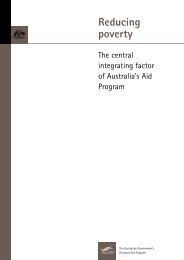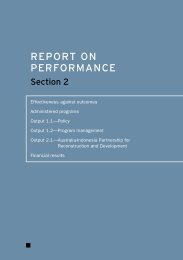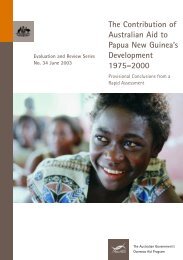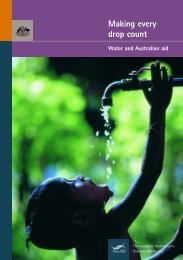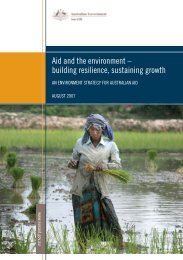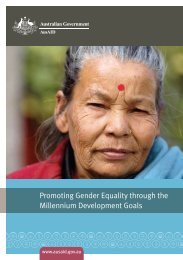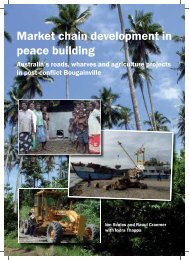ANCP Philippines Cluster Evaluation Report - AusAID
ANCP Philippines Cluster Evaluation Report - AusAID
ANCP Philippines Cluster Evaluation Report - AusAID
You also want an ePaper? Increase the reach of your titles
YUMPU automatically turns print PDFs into web optimized ePapers that Google loves.
<strong>ANCP</strong>Findingschildren. Both NORFIL and CBM were actively engaged in discussions about modelsof development in disability services, and were in some cases influencing policydirection. As a result, the capacity of this partnership to implement the developmentresponse was rated ‘good practice’.PartnershipTwo of the four projects (ABM-ECP and CBM-NORFIL) implemented their <strong>ANCP</strong>projects through intermediary community structures (reflected in the bottom row ofFigure 4). The other two (Reledev-FPTI and SAADO-Propeller Club) engaged in‘direct’ service delivery to their ultimate beneficiaries without the involvement of acommunity-based structure. The evaluation team formed the view that the latterapproach was less sustainable owing to the donor dependence on recurrent costsand the less evident ‘community empowerment’ aspect (see discussion in Section3.4).Two of the four partnerships (ABM-ECP and CBM-NORFIL) were long-termrelationships with no explicit end-point; and extended beyond the scope of the <strong>ANCP</strong>.ABM’s engagement with ECP was prescribed by the church’s structure; and CBM’spartnership with NORFIL had evolved out of aligned objectives and philosophy. Incontrast, both the Reledev-FPTI and SAADO-Propeller Club relationships were shortterm(3 years, reviewed annually) and defined by the scope of the <strong>ANCP</strong> projects.Nevertheless all four NGO partnerships demonstrated compatibility in terms of theirpurpose and practice 25 ; and all four reported positive and constructive workingrelationships. Arguably the strongest partnership (applying the ACFID perspective)was between ABM and ECP. In this case, both the rhetoric and the reality wereindicative of a commitment to explore new dimensions of partnership. Examplesincluded ABM commissioning ECP to conduct review of their capacity in Australia;both partners jointly negotiating three-year partnership agreements; both partnerssitting on their respective strategic committees.Three of the four ANGOs explicitly supported capacity development of their LNGOpartner organisations. The exception, SAADO, acted predominantly as a financialpartner, arguing that the LNGO had strong management capacity (the PropellerClub’s board comprises executives of companies involved in the shipping industry).Nevertheless, the evaluation team wondered if SAADO could have been moreproactive in building the development capacity of the Propeller Club and exploring thepotential community impact of the project. Reledev’s role in building the capacity ofFPTI to comply with recently adopted GoP competency-based training requirementswas particularly timely, and contributed to strengthening the industry standing of theorganisation.Intriguingly, while ACFID’s NGO Effectiveness Framework 26 identifies networking andcoordination between NGOs for development synergy as a core aspect of NGOeffectiveness strategy, this did not feature strongly among any of the sampled NGOs.Recommendation5. ANGOs should explore practical measures to facilitate synergies and partnershipbetween in-country partners.6. ACFID should review the purpose of the ‘networking and coordination’ standard in theNGO Effectiveness Framework, and articulate its relevance to member NGOs.3.3 Development Strategy25Even SAADO (an evangelical church) and the Propeller Club (a business club) were aligned for the purposes oftheir project.26The ACFID NGO Effectiveness Framework has been adopted as a fundamental element of <strong>AusAID</strong>’s <strong>Cluster</strong><strong>Evaluation</strong> Framework (see Section 2.2).<strong>ANCP</strong> <strong>Philippines</strong> <strong>Cluster</strong> <strong>Evaluation</strong> <strong>Report</strong> (ver. 2.0) 9


